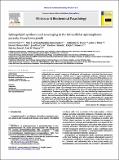Por favor, use este identificador para citar o enlazar a este item:
http://hdl.handle.net/10261/82105COMPARTIR / EXPORTAR:
 SHARE SHARE
 CORE
BASE CORE
BASE
|
|
| Visualizar otros formatos: MARC | Dublin Core | RDF | ORE | MODS | METS | DIDL | DATACITE | |

| Título: | Sphingolipid synthesis and scavenging in the intracellular apicomplexan parasite, Toxoplasma gondii |
Autor: | Casas, Josefina CSIC ORCID ; Denny, Paul W. | Fecha de publicación: | 2013 | Editor: | Elsevier | Citación: | Molecular and Biochemical Parasitology 187(1): 43-51 (2013) | Resumen: | Sphingolipids are essential components of eukaryotic cell membranes, particularly the plasma membrane, and are involved in a diverse array of signal transduction pathways. Mammals produce sphingomyelin (SM) as the primary complex sphingolipid via the well characterised SM synthase. In contrast yeast, plants and some protozoa utilise an evolutionarily related inositol phosphorylceramide (IPC) synthase to synthesise IPC. This activity has no mammalian equivalent and IPC synthase has been proposed as a target for anti-fungals and anti-protozoals. However, detailed knowledge of the sphingolipid biosynthetic pathway of the apicomplexan protozoan parasites was lacking. In this study bioinformatic analyses indicated a single copy orthologue of the putative SM synthase from the apicomplexan Plasmodium falciparum (the causative agent of malaria) was a bona fide sphingolipid synthase in the related model parasite, Toxoplasma gondii (TgSLS). Subsequently, TgSLS was indicated, by complementation of a mutant cell line, to be a functional orthologue of the yeast IPC synthase (AUR1p), demonstrating resistance to the well characterised AUR1p inhibitor aureobasidin A. In vitro, recombinant TgSLS exhibited IPC synthase activity and, for the first time, the presence of IPC was demonstrated in T. gondii lipid extracts by mass spectrometry. Furthermore, host sphingolipid biosynthesis was indicated to influence, but be non-essential for, T. gondii proliferation, suggesting that whilst scavenging does take place de novo sphingolipid synthesis may be important for parasitism. © 2012 Elsevier B.V. | Descripción: | Open Access.-- et al. | Versión del editor: | http://dx.doi.org/10.1016/j.molbiopara.2012.11.007 | URI: | http://hdl.handle.net/10261/82105 | DOI: | 10.1016/j.molbiopara.2012.11.007 | Identificadores: | doi: 10.1016/j.molbiopara.2012.11.007 issn: 0166-6851 |
| Aparece en las colecciones: | (IQAC) Artículos |
Ficheros en este ítem:
| Fichero | Descripción | Tamaño | Formato | |
|---|---|---|---|---|
| Sphingolipid synthesis.pdf | 1,07 MB | Adobe PDF |  Visualizar/Abrir |
CORE Recommender
PubMed Central
Citations
15
checked on 10-abr-2024
SCOPUSTM
Citations
24
checked on 15-abr-2024
WEB OF SCIENCETM
Citations
21
checked on 24-feb-2024
Page view(s)
290
checked on 24-abr-2024
Download(s)
292
checked on 24-abr-2024
Google ScholarTM
Check
Altmetric
Altmetric
Artículos relacionados:
NOTA: Los ítems de Digital.CSIC están protegidos por copyright, con todos los derechos reservados, a menos que se indique lo contrario.
